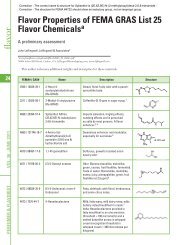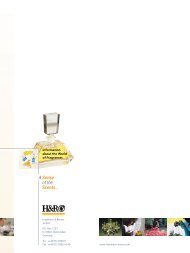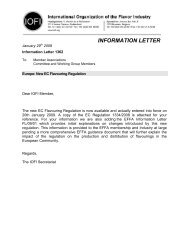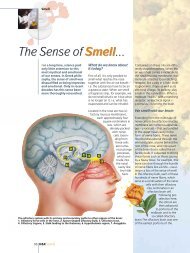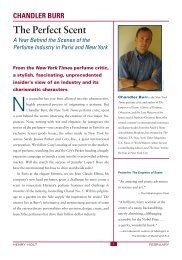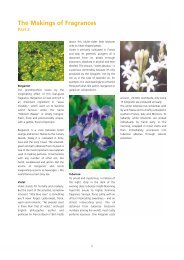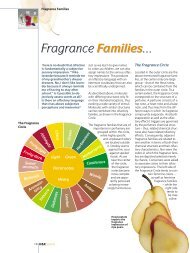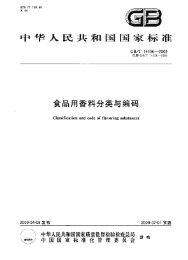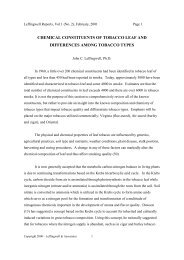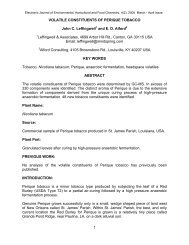Odds & Trends in F&F - Leffingwell & Associates
Odds & Trends in F&F - Leffingwell & Associates
Odds & Trends in F&F - Leffingwell & Associates
Create successful ePaper yourself
Turn your PDF publications into a flip-book with our unique Google optimized e-Paper software.
<strong>Odds</strong> & <strong>Trends</strong> <strong>in</strong> F&F – Technical<br />
Evolution & Information Revolution<br />
John C. Leff<strong>in</strong>gwell<br />
Society of Flavor Chemist’s<br />
November 20, 2008<br />
Revised Jan. 20, 2009
3000<br />
2500<br />
2000<br />
1500<br />
1000<br />
Additions to Orig<strong>in</strong>al GRAS List<br />
Cumulative Number of GRAS Items<br />
Number<br />
GRAS 3<br />
GRAS 4<br />
GRAS 5<br />
GRAS 6<br />
GRAS 7<br />
GRAS 8<br />
GRAS 9<br />
GRAS 10<br />
GRAS 11<br />
GRAS 12<br />
GRAS 13<br />
GRAS 14<br />
GRAS 15<br />
GRAS 16<br />
GRAS 17<br />
GRAS 18<br />
GRAS 19<br />
GRAS 20<br />
GRAS 21<br />
GRAS 22<br />
GRAS 23<br />
GRAS 24
200<br />
150<br />
100<br />
50<br />
0<br />
Additions to Orig<strong>in</strong>al GRAS List<br />
Number of GRAS Items<br />
Number<br />
GRAS 4<br />
GRAS 5<br />
GRAS 6<br />
GRAS 7<br />
GRAS 8<br />
GRAS 9<br />
GRAS 10<br />
GRAS 11<br />
GRAS 12<br />
GRAS 13<br />
GRAS 14<br />
GRAS 15<br />
GRAS 16<br />
GRAS 17<br />
GRAS 18<br />
GRAS 19<br />
GRAS 20<br />
GRAS 21<br />
GRAS 22<br />
GRAS 23<br />
GRAS 24<br />
20+ % from GRAS 22, 23 and the forthcom<strong>in</strong>g GRAS 24
Technical Evolution of the F&F Industry<br />
• 50’s to 80’s – Instrumentation - IR, NMR, GC-MS<br />
• 90’s to Present – Application of Drug design<br />
techniques, SAR, Biotechnology, Genomics<br />
• Today's Examples:<br />
• Receptor gene expression & ligand (agonist)<br />
screen<strong>in</strong>g for new potent tastants, flavor modifiers,<br />
cool<strong>in</strong>g agents, sweetness enhancers, etc.<br />
• Methodology – Fluorescent Calcium Imag<strong>in</strong>g (EC 50 )<br />
to measure a ligands potency aga<strong>in</strong>st a receptor
Thermo TRP Receptors & Agonists<br />
Table 4 Thermoreceptor Agonists<br />
Chemical agonist (botanical source)<br />
Capsaic<strong>in</strong> (hot chilli peppers, e.g., Tabasco)<br />
Piper<strong>in</strong>e (black pepper corns)<br />
Allic<strong>in</strong> (fresh garlic)<br />
Camphor (C<strong>in</strong>namomum camphora)<br />
D-9-Tetrahydrocannab<strong>in</strong>ol (Cannabis sativa)<br />
2-Am<strong>in</strong>oethoxydiphenyl borate (synthetic)<br />
4-a-phorbol 12,13-didecanoate (synthetic)<br />
(-)-Menthol (pepperm<strong>in</strong>t)<br />
1,8-C<strong>in</strong>eole, eucalyptol (eucalyptus)<br />
WS-3 (synthetic)<br />
Icil<strong>in</strong> (synthetic)<br />
C<strong>in</strong>namaldehyde (c<strong>in</strong>namon, cassia)<br />
Allyl isothiocyanate (mustard, horseradish)<br />
Benzyl isothiocyanate (mustard, horseradish)<br />
Phenethyl isothiocyanate (mustard, horseradish)<br />
ThermoTRP<br />
TRPV1<br />
TRPV1<br />
TRPV1, TRPA1<br />
TRPV3, TRPV1<br />
TRPV2, TRPA1<br />
TRPV1, TRPV2, TRPV3<br />
TRPV4<br />
TRMP8, TRPV3<br />
TRPM8<br />
TRPM8<br />
TRPM8, TRPA1<br />
TRPA1, TRPV3<br />
TRPA1<br />
TRPA1<br />
TRPA1<br />
Leff<strong>in</strong>gwell, Handbook of Cosmetic Science and Technology, 3d edition (2009), In Press
Amide GRAS Cool<strong>in</strong>g Agents Thru GRAS 23<br />
H<br />
N<br />
O<br />
O<br />
N<br />
H<br />
WS-3<br />
FEMA 3455<br />
1.5 X Menthol<br />
WS-23<br />
FEMA 3804<br />
0.75 X Menthol<br />
O<br />
H<br />
N<br />
WS-5<br />
FEMA 4309<br />
4 X Menthol<br />
CO 2 Et<br />
O<br />
O<br />
Menthyl N,N-dimethylsucc<strong>in</strong>amide<br />
FEMA 4230<br />
O<br />
N
Relative Potency of TRPM8 agonists based on EC 50<br />
values (mean) with (-)-Menthol = 100<br />
Hydroxy-citronellal (EC50 = 19.6±2.2 mM)<br />
0.02<br />
eucalyptol (EC50 = 7.7±2.0 mM)<br />
l<strong>in</strong>alool (EC50 = 6.7±2.0 mM)<br />
geraniol (EC50 = 5.9±1.6 mM)<br />
Coolact P (-)-Isopulegol (EC50 =66±1.2 µM)<br />
WS-23 (EC50 = 44±7.3 µM)<br />
PMD-38 (EC50 = 31±1.1 µM)<br />
(+)menthol (EC50 = 14.4±1.3 µM)<br />
Cool<strong>in</strong>g-agent 10 (EC50 = 6±2.2 µM)<br />
Frescolat MGA (EC50 = 4.8±1.1 µM)<br />
(-)menthol (EC50 = 4.1±1.3 µM)<br />
WS-3 (EC50 = 3.7±1.7 µM)<br />
Frescolat ML (EC50 = 3.3±1.5 µM)<br />
0.05<br />
0.06<br />
0.07<br />
6.2<br />
9.3<br />
13<br />
28<br />
66<br />
85<br />
100<br />
111<br />
124<br />
0 20 40 60 80 100 120 140<br />
Note - Icil<strong>in</strong> (EC 50 =0.2±0.1 µM) not shown<br />
(Relative icil<strong>in</strong> potency vs (-)-Menthol at 100 is 2050) - Adapted<br />
from Behrendt, et .al, Brit. J. Pharm., 141:737-745 (2004)
Givaudan’s New Powerful GRAS Cool<strong>in</strong>g Agents<br />
Furrer et al., Chem. Percept. (July 2008) 1:119–126; Galop<strong>in</strong> et al., US Patent<br />
7,414,152 (August 19, 2008); Bell et al., WO2007019719 (Feb. 22, 2007)<br />
H<br />
N<br />
H<br />
N<br />
O<br />
2j = FEMA 4496<br />
10X Menthol<br />
CN<br />
O<br />
N<br />
2k = FEMA 4549<br />
40-100X Menthol
New GRAS 24 Related Cool<strong>in</strong>g Agents<br />
O<br />
N<br />
H<br />
O<br />
N<br />
H<br />
Menthyl<br />
cyclopropanecarboxamide<br />
FEMA 4558<br />
Not Cool<strong>in</strong>g – Umami-like<br />
U.S. Patent Application 20080292763<br />
N-Ethyl-2,2-diisopropylbutanamide<br />
FEMA 4557<br />
O<br />
H<br />
N<br />
N<br />
O<br />
H<br />
N<br />
CN<br />
OH<br />
N-(2-(Pyrid<strong>in</strong>-2-yl)ethyl)-3-pmenthanecarboxamide<br />
FEMA 4549<br />
40-100 X Menthol<br />
N-p-Benzeneacetonitrilementhanecarboxamide<br />
FEMA 4496<br />
10 X Menthol<br />
Cubebol<br />
FEMA 4497
New GRAS Warm<strong>in</strong>g / Pungent Agents<br />
O<br />
O<br />
O<br />
O<br />
O<br />
O<br />
Galangal acetate<br />
Not GRAS but Galangal extracts are<br />
Yang & Eilerman, J. Agric. Food<br />
Chem. 1999, 47, 1657-1662<br />
O<br />
O<br />
Dihydrogalangal acetate<br />
FEMA 4555<br />
Bachmann et al. EP1700525<br />
Wasabi-like GRAS 23 Warm<strong>in</strong>g / Pungent Agents<br />
Eruc<strong>in</strong> – FEMA 4414<br />
Lesquerell<strong>in</strong> – FEMA 4415<br />
Bertero<strong>in</strong> – FEMA 4416<br />
Amyl isothiocyanate – FEMA 4417<br />
3-Butenyl isothiocyanate – FEMA 4418<br />
sec-Butyl isothiocyanate – FEMA 4419<br />
Ethyl isothiocyanate – FEMA 4420<br />
5-Hexenyl isothiocyanate – FEMA 4421<br />
Hexyl isothiocyanate – FEMA 4422<br />
Isoamyl isothiocyanate – FEMA 4423<br />
Isobutyl isothiocyanate – FEMA 4424<br />
Isopropyl isothiocyanate – FEMA 4425<br />
Methyl isothiocyanate – FEMA 4426<br />
4-pentenyl isothiocyanate – FEMA 4427<br />
Benzyl isothiocyanate – FEMA 4428
Taste Receptors<br />
L<strong>in</strong>demann, Nature 413: 219-225 (2001)<br />
Salt & Sour Receptors are Ion<br />
Channels<br />
Umami, Sweet & Bitter Receptors<br />
are GPCR Receptors<br />
For examples (sweet and umami) - See Li et al., PNAS, 2002, 99 (7) 4692-4696
Diverse Compounds are Sweet<br />
Diverse Compounds are Sweet<br />
HO<br />
HO<br />
OH<br />
Cl<br />
HO<br />
OH<br />
HO<br />
O<br />
O<br />
OH<br />
HO<br />
O<br />
O<br />
Cl<br />
HO<br />
OH<br />
Cl<br />
OH<br />
Thaumat<strong>in</strong><br />
OH<br />
Sucrose<br />
OH<br />
Sucralose<br />
O<br />
HO<br />
O<br />
NH 2<br />
O<br />
N<br />
H<br />
O<br />
O<br />
N - K +<br />
O S O<br />
O<br />
Brazze<strong>in</strong><br />
Aspartame<br />
O<br />
S<br />
O<br />
NH<br />
Sacchar<strong>in</strong><br />
O<br />
Acesulfame K<br />
O<br />
S<br />
NH<br />
O -<br />
Na +<br />
O<br />
Cyclamate<br />
Monell<strong>in</strong>
Multiple Regions of T1R2+T1R3 are Required for<br />
Effective Interaction with Different Sweet Compounds<br />
R. F. Margolskee, Sci. STKE, 28 June 2005
Multiple Regions of T1R2+T1R3 are Required for<br />
Effective Interaction with Different Sweet Compounds<br />
T1R2 Am<strong>in</strong>o Term<strong>in</strong>al Doma<strong>in</strong><br />
small molecule sweeteners<br />
T1R3 C-Rich Region<br />
Brazze<strong>in</strong><br />
T1R3 Transmembrane Region<br />
Cyclamate, Lactisole<br />
R. F. Margolskee, Sci. STKE, 28 June 2005
Sweet Prote<strong>in</strong> Brazze<strong>in</strong> Docked to the T1R3 Subunit<br />
Walters et al., J Agric Food Chem. 2006; 54(26): 10129–10133
Synomyx Sweetness Enhancers<br />
Synomyx Sweetness Enhancers<br />
November 5, 2008 – Senomyx receives GRAS status for<br />
S2383 – an enhancer that allows a 75% reduction of<br />
Sucralose<br />
November 6, 2008 – Senomyx enters a collaborative<br />
commercialization and license agreement with<br />
Firmenich for S2383<br />
Senomyx has also <strong>in</strong>itiated development activities for<br />
S6973, a new sucrose enhancer that enables up to a<br />
50% reduction of sucrose <strong>in</strong> taste tests with beverage,<br />
yogurt, and other product prototypes<br />
What are S2383 & S6973 = ?? At the moment, but…
Synomyx Sweetness Enhancers<br />
Synomyx Sweetness Enhancers<br />
% Fructose / Glucose Reduction<br />
60<br />
50<br />
50<br />
40 40<br />
% Reduction<br />
40<br />
30<br />
20<br />
10<br />
30<br />
CN<br />
0<br />
Compound<br />
22<br />
Compound<br />
23<br />
Compound<br />
30<br />
EC 50<br />
0.14 µM EC 50<br />
0.15 µM EC 50<br />
0.61 µM<br />
CN<br />
O<br />
Compound<br />
21<br />
EC 50<br />
0.07 µM<br />
CN<br />
N<br />
O<br />
N<br />
O<br />
O<br />
N<br />
O<br />
N<br />
H<br />
Compound 22<br />
N<br />
H<br />
Compound 23 Compound 30<br />
N<br />
H<br />
N<br />
H<br />
Compound 21<br />
Tachdjian et al.. US Patent Application 20070003680 (2007)
3-Hydroxy & Dihydroxybenzoic acids as Sweetness Enhancers<br />
Effect of Blend Ratios on Sucrose Reduction<br />
60<br />
50<br />
45<br />
49<br />
% Reduction<br />
40<br />
30<br />
20<br />
15<br />
25 26<br />
34<br />
10<br />
O<br />
0<br />
2,4-DHB 3-HB 3,4-DHB +<br />
2,4-DHB<br />
1000 ppm 1000 ppm 500 ppm<br />
each<br />
O<br />
3-HB +<br />
3,4-DHB<br />
500 ppm<br />
each<br />
3-HB +<br />
2,4-DHB<br />
500 ppm<br />
each<br />
3-HB +<br />
2,4-DHB +<br />
3,4-DHB<br />
500 ppm<br />
each<br />
OH<br />
O<br />
HO<br />
OH<br />
HO<br />
OH<br />
OH<br />
3-Hydroxybenzoic acid<br />
FEMA 4431<br />
HO<br />
3,4-Dihydroxybenzoic acid<br />
FEMA 4430<br />
B<strong>in</strong>gley et al, US Patent Application 20070054023 (2007) to Cadbury<br />
HO<br />
2,4-Dihydroxybenzoic acid<br />
FEMA 3798
New GRAS Bitter Blocker<br />
O<br />
OH<br />
cis-4-(2,2,3-Trimethylcyclopentyl)butanoic acid<br />
FEMA 4529<br />
Ungureanu et al., PCT WO2008119197 (Oct. 9, 2008)
Elucidation of Olfactory G-Prote<strong>in</strong> Receptors<br />
Putative B<strong>in</strong>d<strong>in</strong>g cavity <strong>in</strong> Human OR1.04.06<br />
900+ Human Olfactory Receptor Genes Identified – D. Lancet<br />
~600 Pseudogenes + ~300 Intact Genes<br />
Glusman, Yanai, Rub<strong>in</strong>, Lancet, Genome Res. 2001 May;11(5):685-702;<br />
Zozulya, Echeverri, Nguyen, Genome Biology 2001, 2(6):research0018.1–<br />
0018.12; Malnic, Godfrey, Buck, PNAS, 2004, 101 (8), 2584–2589
Phylogenetic tree of sequence relationships among ORs<br />
Lyral<br />
Limonene<br />
Carvone<br />
(-)-Citronellal<br />
Bourgeonal<br />
Helional<br />
2-Heptanone<br />
Ethavan*<br />
Malnic, Godfrey, Buck, PNAS, 2004, 101 (8), 2584–2589<br />
Eugenol
Prediction of Perception: Prob<strong>in</strong>g the hOR17-4 Olfactory Receptor<br />
Model with Silicon Analogues of Bourgeonal and Lilial<br />
L. Doszczak, P. Kraft, et al., Angew. Chemie, 46 (18), 2007, 3367-3371
Prediction of Perception: Prob<strong>in</strong>g the hOR17-4 Olfactory Receptor<br />
Model with Silicon Analogues of Bourgeonal and Lilial<br />
O<br />
O<br />
Bourgeonal<br />
Lilial<br />
O<br />
O<br />
Si<br />
Si<br />
Sense and sensibility: Silicon analogues of the lily-of-thevalley<br />
odorants Lilial and Bourgeonal demonstrate that the<br />
electronic surface structure determ<strong>in</strong>es the <strong>in</strong>teraction of an<br />
odorant with its.olfactory receptor. The subtle changes <strong>in</strong><br />
the stereoelectronic properties enable a comparison of <strong>in</strong><br />
vivo, <strong>in</strong> vitro, and <strong>in</strong> silico data. Odor thresholds, as well as<br />
the swimm<strong>in</strong>g behavior of sperm cells, correlate well with<br />
the b<strong>in</strong>d<strong>in</strong>g energies obta<strong>in</strong>ed from a computational model<br />
of the hORl7-4 receptor.<br />
L. Doszczak, P. Kraft, et al., Angew. Chemie, 46 (18), 2007, 3367-3371
Fragrance Materials - Newly GRAS<br />
O<br />
O<br />
O<br />
O<br />
Helional®<br />
FEMA 4599<br />
Floral, green, ozone, mar<strong>in</strong>e<br />
Triplal®, Cyclal C, Vertocitral<br />
FEMA 4505<br />
Green, Citrus, Herbal, Aldehydic<br />
HO<br />
Nerolidol oxide<br />
FEMA 4536<br />
Strawberry- and milk-like fruity<br />
and floral fragrance; red berry flavor<br />
O<br />
O<br />
3,3,5-Trimethylcyclohexyl acetate<br />
FEMA 4512<br />
Brightly fresh-fruity, m<strong>in</strong>ty,<br />
herb-like and floral-roselike<br />
O<br />
O<br />
OH<br />
Safrale<strong>in</strong>e®<br />
FEMA 4556<br />
Leathery, spicy, warm, woody odor,<br />
rem<strong>in</strong>iscent of saffron<br />
Mayol®<br />
FEMA 4507<br />
Fresh floral odor rem<strong>in</strong>iscent of many<br />
flowers - magnolia, tuberose, muguet
The F&F Information Revolution<br />
• 50’s to 90’s –<br />
• Patent Literature – Chemical Abstracts & order a<br />
copy (may take months)<br />
• Bedoukian’s reviews (once a year)<br />
• Numerous periodicals (e.g. Helv. Chim. Acta, J.<br />
Org. Chem., J. Agric. Food Chem. etc.)<br />
• Technical Books (Guenther, Arctander, Bedoukian)<br />
– All time consum<strong>in</strong>g<br />
• Mid 90’s to Present –<br />
• Patents & Patent Applications onl<strong>in</strong>e (searchable)<br />
• Nearly all periodicals onl<strong>in</strong>e (searchable)<br />
• Industry web sites (with lots of free Info)<br />
• Books & P&F on CD-ROM (searchable)<br />
• Lead<strong>in</strong>g F&F databases (searchable)
• Patent Search – all free<br />
Patents<br />
• US Patents – from http://patft.uspto.gov/<br />
Will search from 1975 – present<br />
• Free Patents Onl<strong>in</strong>e – from<br />
http://www.freepatentsonl<strong>in</strong>e.com/<br />
Searches US, EP, WIPO, Japan – all at once** pdf<br />
download<br />
• European Patent Office - http://ep.espacenet.com/<br />
Searches worldwide Patents from the 1800’s** pdf<br />
download<br />
• Search Japanese Patents -<br />
http://www.ipdl.<strong>in</strong>pit.go.jp/homepg_e.ipdl<br />
Has a Japanese to English Patent translator**<br />
** Best sites
Periodicals<br />
• Global Search on any subject**<br />
• Google – will pick up most articles and patents<br />
• Scirus – http://www.scirus.com/ - a scientific search<br />
eng<strong>in</strong>e<br />
• ACS search - http://pubs.acs.org/search/advanced<br />
Searches any and all ACS journals - (abstracts free)<br />
• Wiley InterScience -<br />
http://www3.<strong>in</strong>terscience.wiley.com/search/allsearch<br />
Searches many journals of F&F <strong>in</strong>terest<br />
• ScienceDirect - http://www.sciencedirect.com/<br />
Searches many journals of F&F <strong>in</strong>terest<br />
** In most cases you can purchase <strong>in</strong>dividual articles
Industry web sites<br />
• Perfumer & Flavorist –<br />
http://www.perfumerflavorist.com/ - great site for <strong>in</strong>dustry<br />
news; can purchase P&F magaz<strong>in</strong>e and J. Essential Oil<br />
Res. Articles; Mosciano’s database; Bookstore<br />
• Leff<strong>in</strong>gwell & <strong>Associates</strong> – http://www.leff<strong>in</strong>gwell.com/ -<br />
<strong>in</strong>dustry news (e.g. Top 10 F&F); lots of technical<br />
<strong>in</strong>formation & l<strong>in</strong>ks (all free)<br />
• JECFA – http://www.fao.org/ag/agn/jecfaflav/search.html<br />
- Search JECFA status and specs<br />
• Japanese food & flavor additives -<br />
http://www.ffcr.or.jp/<br />
• EU flavor database – all Flavis numbers<br />
http://ec.europa.eu/food/food/chemicalsafety/flavour<strong>in</strong>g/d<br />
atabase/dsp_search.cfm<br />
• Others – EFSA, FKS, IOFI, FEMA, Good Scents Co.
Books & P&F on CD-ROM<br />
• Arctander's Books on CD-ROM
Books & P&F on CD-ROM
Lead<strong>in</strong>g F&F Software<br />
Leff<strong>in</strong>gwell & BACIS Databases<br />
• Flavor- Base 2007<br />
• ESO 2006 – Database of Essential Oils<br />
• VCF 2000 – Volatile Compounds <strong>in</strong> Foods<br />
• PMP 2001 – Database of Perfumery Materials<br />
• FRM 2001 – Database of Flavor Raw Materials<br />
• PFC 2002 – Perfume & Fragrance Classifications<br />
Beverage & Juice Formulation Software<br />
• Beverage-Master 2004<br />
• Juice-Master 2004
The F<strong>in</strong>al <strong>Odds</strong> & <strong>Trends</strong><br />
GC-MS of Calvatia gigantea<br />
(The Giant Puffball Mushroom)<br />
The giant puffball (Calvatia gigantea) is one of the largest of the<br />
edible mushroom species. It is usually found <strong>in</strong> late summer and<br />
autumn <strong>in</strong> meadows, fields, and forests worldwide. It is only edible<br />
when fresh and is usually consumed with<strong>in</strong> 24 hours of harvest as<br />
the flavor becomes disagreeable on ag<strong>in</strong>g.
GC-MS of Calvatia gigantea Headspace<br />
Figure 1. Headspace Chromatogram of Fresh (FR-1) Calvatia gigantea<br />
(1) 3-Methylbutanal (2) 2-Pentanone (3) Isoamyl alcohol (4) 2-Methyl-1-butanol (5)<br />
Toluene (6) 1-Octene (7) Anisole (8) 1-Octen-3-one (9) 1-Octen-3-ol (10) 3-Octanone<br />
(11) 3-Octanol (12) Limonene (13) N-(2-methylphenyl)formamide tent (14) Methyl<br />
anthranilate (15) Methyl N,N-dimethylanthranilate (16) Methyl N-methylanthranilate
GC-MS of Calvatia gigantea Headspace<br />
Significance – First isolation of anthranilates from<br />
a mushroom species<br />
Source: Leff<strong>in</strong>gwell & Alford, manuscript <strong>in</strong> preparation




